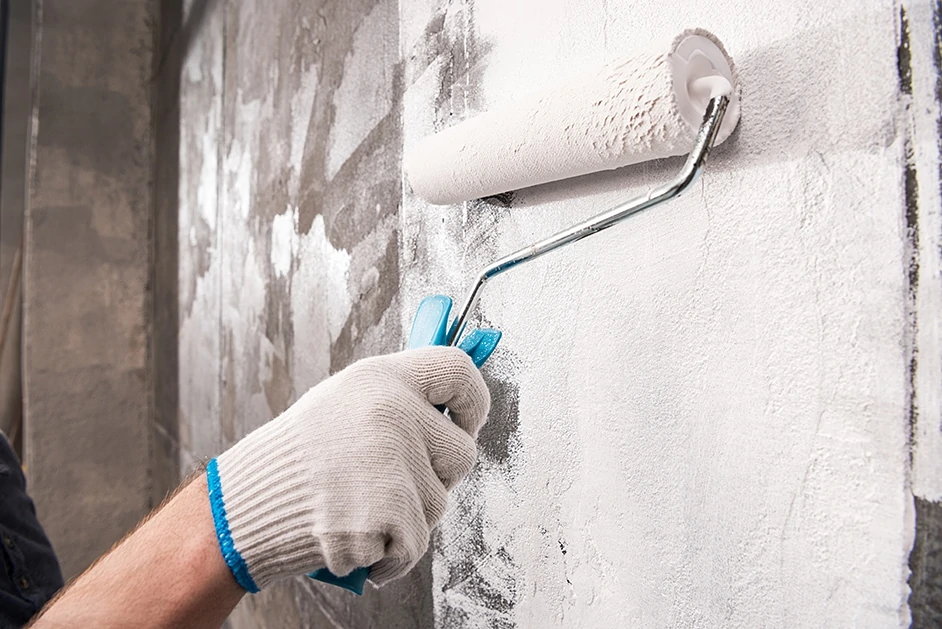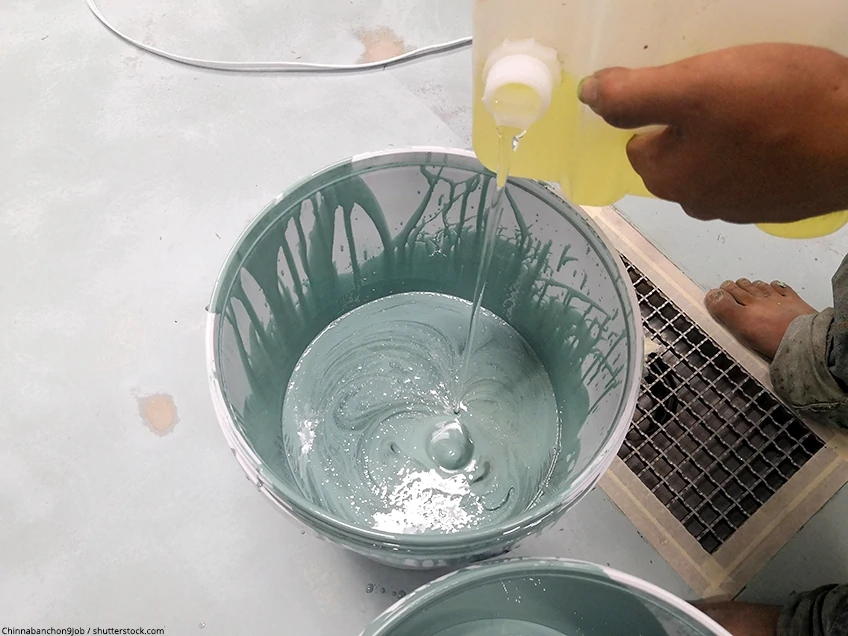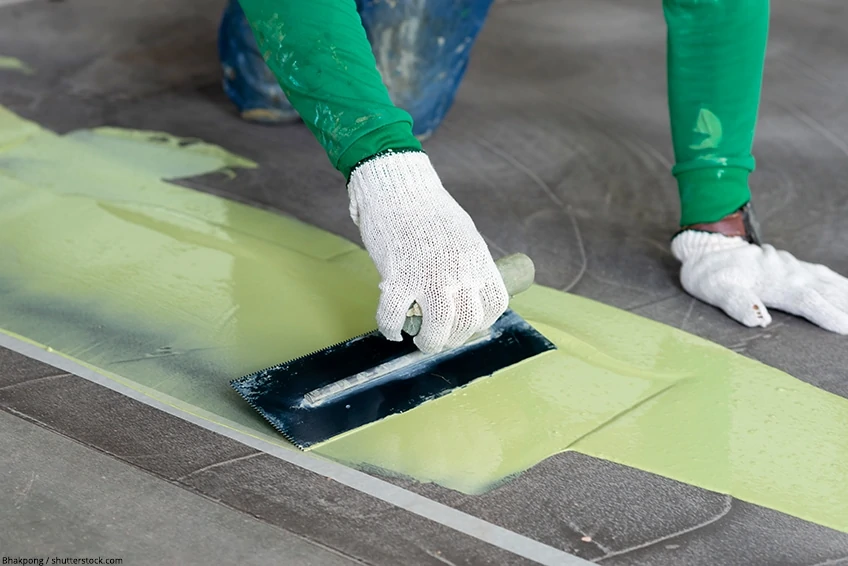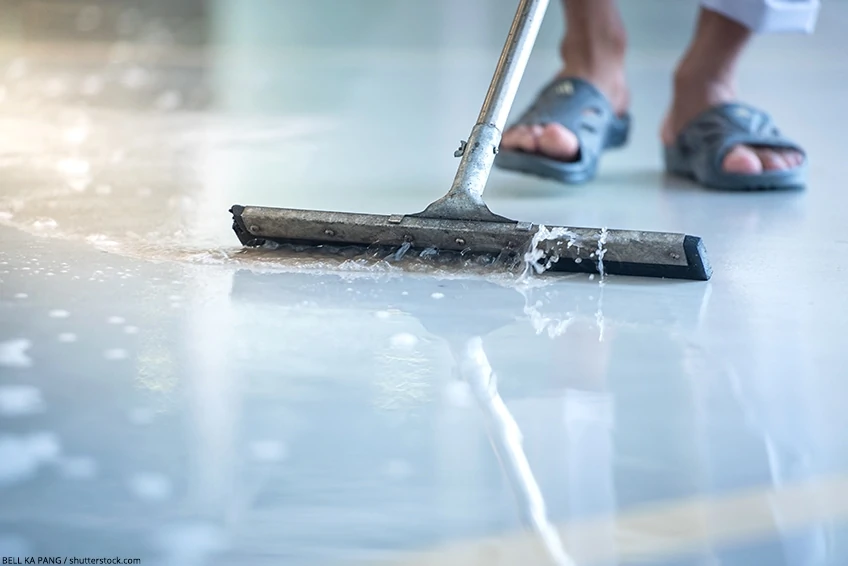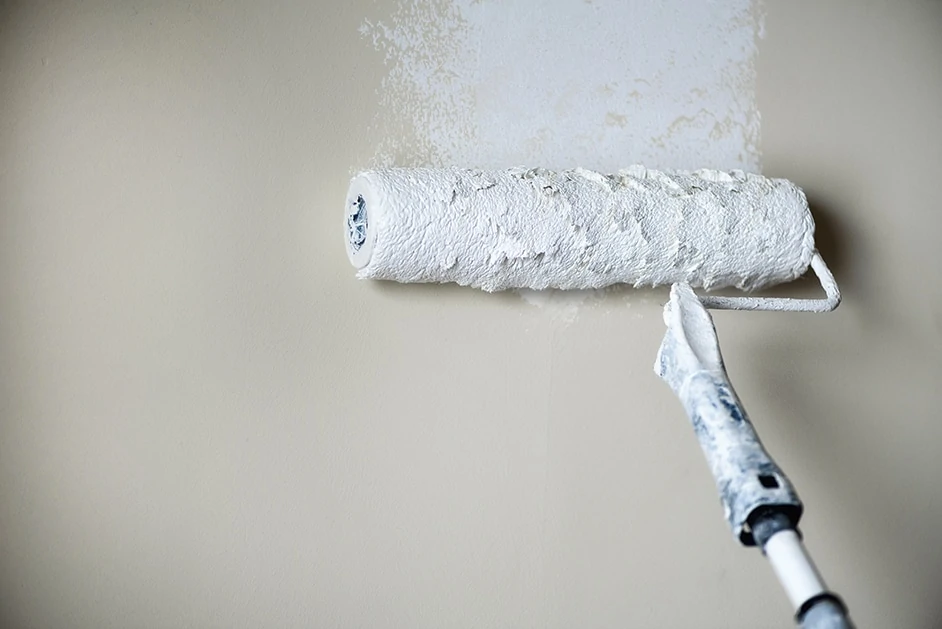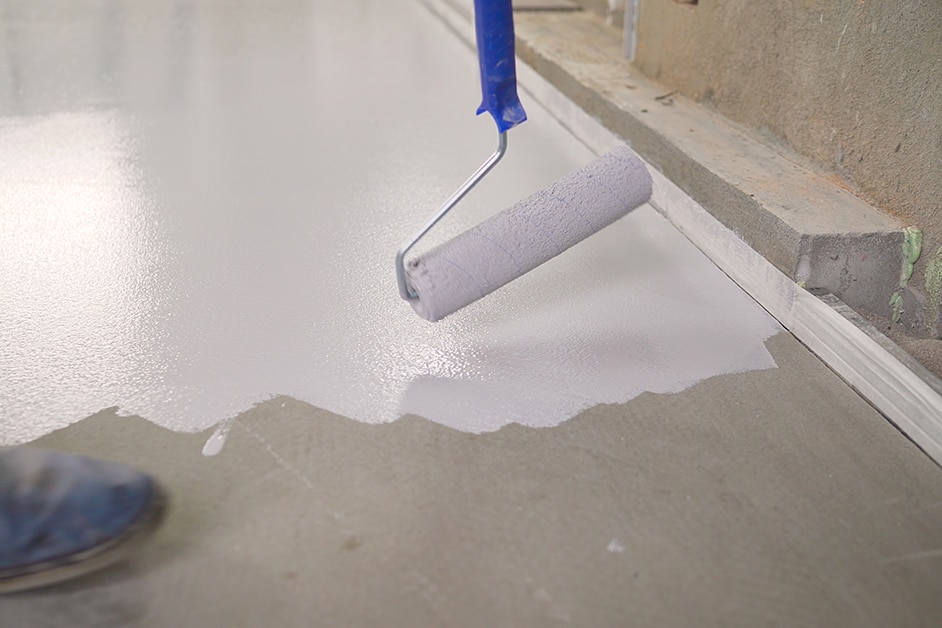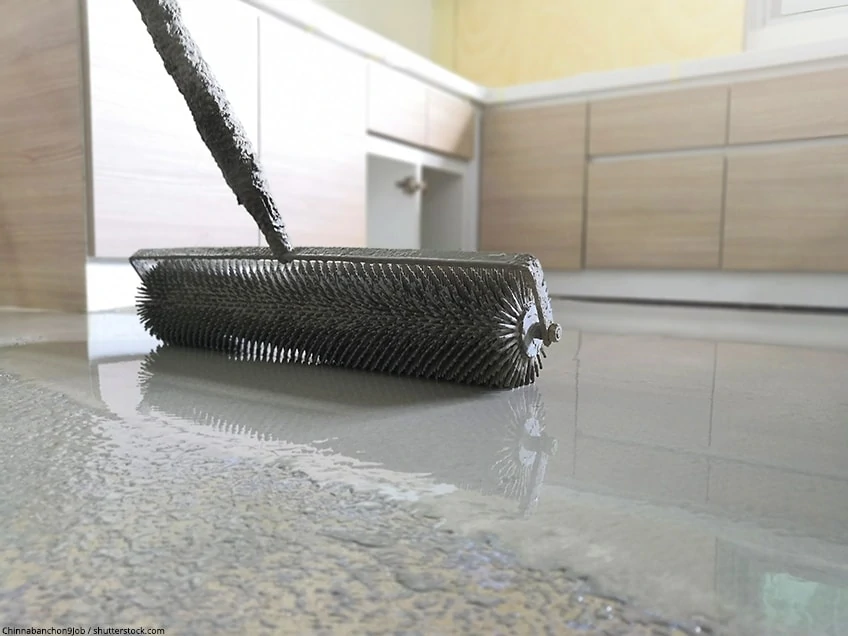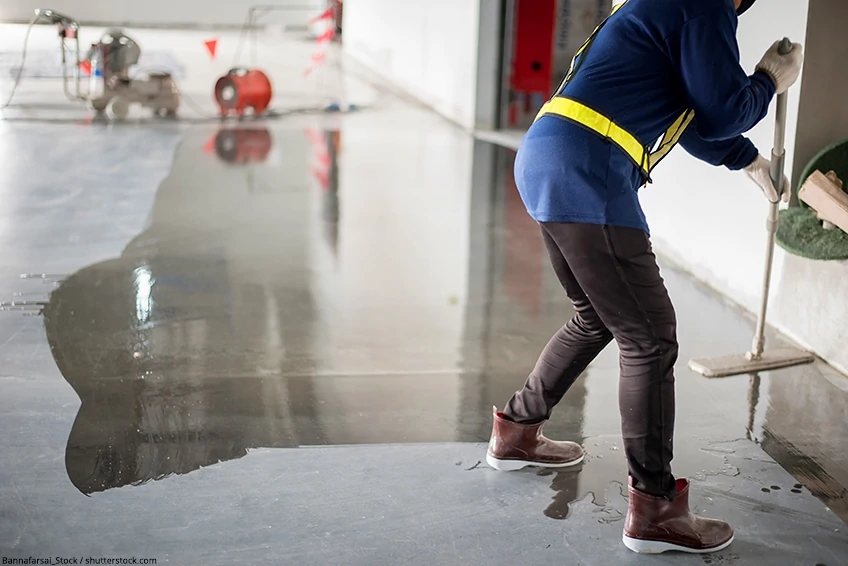How to Paint Concrete – Complete Tutorial
This post may contain affiliate links. We may earn a small commission from purchases made through them, at no additional cost to you. You help to support resin-expert.com
To paint concrete building pieces is not suitable just any paint. For this purpose, special concrete paint should be used for the floor or wall. We show you what you need to know in order to paint concrete and have collected all the tips and tricks for you.
Table of Contents
What is concrete paint?
Concrete is a versatile material that is used especially for walls and masonry, but also as flooring. However, casting concrete alone is not enough: the material is not only a drab shade of gray, it is also very porous and must be protected from damaging influences to increase its longevity. To do this, it must be glazed or painted.
If you want to paint a concrete substrate, concrete paint is just what you need. This not only visually enhances the substrate, but also protects it from environmental influences. Damage caused by weathering and chemicals is optimally repelled by concrete paint, which also includes rust damage. The latter can be caused by too much moisture in the material and, in the worst case, result in structural problems and costly repairs.
It does not matter what kind of concrete substrate it is, because concrete paint is suitable for.
-
- Basement floors
- Base and piers
- Facades
- Garage floors and walls
- Concrete art objects
Concrete paints are available as 1K concrete paints as well as 2K concrete paints. 2K concrete paints are, for example, epoxy resin concrete paints. These consist of two components that react as soon as they come into contact with each other.
They are pleasant to apply and offer high durability with the simplest maintenance. Cleaning is very easy, as the epoxy concrete paint has an almost mirror-like surface. Furthermore, epoxy concrete paints are not only environmentally friendly; they are even available with antibacterial properties, which makes them even easier to maintain.
Epoxy concrete paint for the floor or wall also offers the advantage of being able to be applied on top of all existing coatings. After a very short drying time, the 2K concrete paint is enormously durable.
Advantages and disadvantages of concrete paint
With numerous advantages, concrete has only two disadvantages, but they do not weigh very heavily:
Advantages
-
- It protects the substrate from damage caused by weather
- Concrete paint itself has a long service life and also extends the life of the substrate
- The application of paint is so simple that it is suitable even for users without craft experience
- The opacity is very high
- A wide variety of colors is available; you can also purchase transparent concrete paint
- Most colors do not require primer
- Indoor concrete paint is highly low in pollutants
- Not only concrete, but all mineral substrates are suitable for the paints
- The paints are low in solvents and almost odorless
- They have excellent UV resistance
- There is a high resistance to abrasion
- The paints are also oil as well as water resistant
Disadvantages.
-
- Some colors require a primer
- The colors can be relatively expensive
Neither factor can actually be considered a real disadvantage; this is especially true for price. For example, concrete paint greatly increases the longevity of the underlying material, which, in the long run, saves money and time. Also, the prior priming in some concrete paints can not be considered a real disadvantage, because this is neither very time-consuming nor costly.
How to Paint Concrete Surfaces
In order to apply a concrete paint and achieve not only a radiant result, but also a long-lasting result, there are a few things that need to be taken into account. Below we will give you instructions on how to paint with concrete paint.
Removal of loose paint
To achieve perfect adhesion of concrete paint, the substrate must first be prepared. This includes removing the paint that is still on it. This can be done with smaller areas with the help of a wire brush. However, this process works faster and more effectively with a sandblaster or a high-pressure cleaner.
Alternatively, you can stain the surface. However, you should be sure that the stain is suitable for the underlying paint layer and that the substrate is resistant to the stain. If in doubt, stripping with a sandblaster is a better solution.
Burning away the old concrete paint with the help of hot air is also an option, but this is also associated with limitations. Not all concrete paint can be removed with heat, and not every floor tolerates this treatment well. It also produces fumes that are not particularly conducive to good health.
So if you want to remove the old paint by pickling or hot air, it is best to contact a professional beforehand
.
After the old paint is removed, the surface to be painted must be thoroughly cleaned. There should be no dust, dirt, oil or grease stains on it during the painting process. A floor that is to be painted with concrete paint is therefore first vacuumed and then cleaned of grease and oil stains using special cleaners. This last step is very important, because concrete paint will not stick to a greasy or oily surface.
Now you can fill cracks, dents and crevices with a leveling compound or epoxy mortar. Allow the areas to dry thoroughly and sand them down to get a flat surface. After that, of course, the surface must be cleaned of dust again.
If you have evened out any unevenness and cleaned the substrate, it may still need to be roughened. This leads to better adhesion of the paint. You can use a special etching solution for this purpose.
Primer
In order for you to achieve optimum ink adhesion, the substrate must usually be primed. Which primer you use depends on the concrete color you want to apply. For the respective recommendations, refer to the data sheet of the paint or contact the manufacturer. Either prime with deep primer or simply use thinned paint. It is also best to follow the data sheet for the amount of water used for thinning.
In rooms where there is high humidity, it is also advisable to apply a sealer coat before applying the paint. Allow all layers to dry thoroughly, and it is better to give them a little more time to do so than too little.
Application of concrete paint
Once the previously applied layers are thoroughly dry, you still need to secure the work area first. Especially if you do not want to cover the entire room with concrete paint, areas that must remain free should be protected from the paint. To do this, you can apply foil to these areas or mask them off.
Now you can apply the concrete paint. Use either a paint roller or a paint sprayer for this purpose. A paint sprayer when applying concrete color has some advantages. The application of the paint is quick and easy and the result looks uniform and therefore very professional. Especially when applying concrete paint on walls, a paint sprayer is advantageous.
The purchase of such is not exactly cheap, but it is worth it. A surface that has been sprayed instead of rolled is more weather resistant and more resistant to mold and chemicals. Especially on a wood substrate, these advantages should not be underestimated. Also, the paint doesn’t drip down like it does when you use a paint roller – so application is not only faster and more professional, but also much cleaner. Keep in mind that when using a spray gun, the paint must be thinned or its nozzle will clog.
Just when using a spray gun, pay attention to personal safety! Use protective clothing and a respirator and ventilate the room thoroughly.
Allow the paint to dry thoroughly after painting. How long the drying time is, see the respective data sheet.
After the first coat, a second may be needed, for example, if the substrate is still slightly shimmering through or the color is not yet intense enough for your personal taste.
Maintenance of the surface
How exactly the concrete surface is cleaned depends on where it is located and whether it was sealed with the waterproof layer after the paint application. In our guide, we assume an unsealed layer of paint on an interior floor.
This should be cleaned as dry as possible, at most damp with a mist. After damp cleaning, it should be wiped dry and then given the opportunity for a complete drying process. For cleaning, use a care product that is suitable for the floor. This should be mild so that it does not attack the paint layer.
In the case of stubborn stains, a cleaning agent should also be used that is matched to the concrete color. If you have any questions about this, you can contact the manufacturer. Keep the contact time of the cleaning agents as short as possible.
The appropriate concrete paint interior / application areas
Between the concrete paint for exterior and concrete paint for interior use, there are differences that should not be ignored. Thus, concrete paints for outdoor use often contain biocidal substances, as they are intended to protect the underlying masonry from algae and moss formation. Paints containing substances that pose a health risk are, of course, not suitable for interior use. In addition, UV resistance plays only a minor role here. An exception to this is very light-flooded rooms, for example those with glass fronts.
On the other hand, diffusion openness plays a major role. The paints should be easily permeable to water, so that the moisture that inevitably arises indoors does not condense on the walls and escape.
Following paints are suitable for interior concrete coating:.
-
- Chalk colors
- Lime colors
- Acrylic paints
- Silicate paints
Concrete walls inside
Silicate paints are excellent as concrete paint inside due to their alkaline PH value. They optimally prevent mold growth. They are also easy to apply and are harmless to the health of humans and animals.
In the interior, concrete walls can be designed not only in a single color, but also with large-scale motifs. For example, you can apply colorful artwork or gaudy graffiti with concrete paint. To do this, you should first prime the substrate so that you can then obtain the desired color result.
Painting concrete floor
In order to find the appropriate concrete paint for your concrete floor, it is first necessary to consider what loads the floor is exposed to. A concrete floor in a garage or workshop has different mechanical loads than one in a living room.
In the interior of an apartment, the paints should be first of all non-toxic, but also have a high durability. The paints should not fade and in bright rooms with large windows should have a certain UV resistance.
If a garage floor is to be painted with concrete paint, mechanical stress from furniture and shoes is compounded by abrasion from car tires and heavy tools, if applicable.
By the way, a very popular and even slightly more noble alternative for the interior is also the epoxy resin floor or a garage floor coating with epoxy resin. You can find more about this in our extra articles.
The right concrete paint exterior / application areas
The application areas for concrete paint exterior are diverse. So not only facades, garden walls and sculptures can be protected with the appropriate concrete paint outside, but also swimming pools, pond and fountain substrates.
Which properties the concrete color should have, varies. For a fountain or a pond, the concrete paint should be as waterproof as possible, but also algae repellent. For this it needs a slightly biocidal effect. However, care should be taken when using it in swimming pools or ponds with fish, because biocides are of course not harmless to humans and animals either.
Exterior concrete paint for terraces and balconies, as well as paint for facades, should have high UV as well as weather resistance. Especially concrete patio slabs are exposed to many weather conditions. As a result, unsightly stains can form or the terrace slabs that are exposed to the blazing sun fade more over time than those that lie in the shade. By painting the exterior of the patio with concrete paint, you can easily repair such damage and restore an attractive appearance and increased protection factor. At the same time, painting with concrete paint for the exterior is not as time-consuming and costly as replacing individual patio slabs or tiles.
Walls and floors exterior
To decide on the right exterior concrete color, you need to consider several things. All walls that are located outdoors are exposed to the elements. Blazing sun or light-and-shade play, rain, storms, snow and hail can significantly affect the life of concrete. With the right color selection, you can provide the best protection for your concrete wall.
Concrete substrates that are located in shady and damp places often have a lot of moss. This can really eat away at the concrete. To protect the substrate from this, it is best to choose a concrete paint with biocidal effect. However, you should use such a paint only if it is unavoidable, because it is harmful not only for the moss on the concrete wall, but also for the rest of the environment.
Criteria for buying concrete paint
If you have to choose a concrete paint, you should consider several factors. First of all, this should be selected according to its area of application. If you want to buy a concrete paint outside for the terrace, it must have different properties than a concrete paint for the floor in the bedroom. For example, if you want to apply the paint on the floor of a gymnasium or a school, it should definitely be slip-resistant to reduce the risk of injury.
That being said, you should calculate the amount of paint you need before you buy, otherwise you’ll be investing too much money and in the worst case scenario you’ll have to dispose of the paint you don’t need. So calculate the paint consumption per square meter or stick to the manufacturer’s specifications, because often an approximate amount of consumption is already given by the manufacturer.
If you would like to calculate the amount of paint yourself, proceed as follows: Calculate with one liter of paint per six square meters of surface.
An exception to this rule is the application of paint with a spray gun, because here the paint to be applied must be thinned. So you need a little less paint per square meter. If you are unsure about this, it is best to contact the manufacturer or the dealer.
What you should also pay attention to, we tell you below in our concrete paint buying guide.
Substrate
Concrete paint is suitable for very many substrates, but not all. To achieve the best possible results, you should know exactly whether the chosen paint is optimal for your purpose.
Concrete paint is suitable for both concrete walls and floors, but also for house plinths, swimming pool and fountain floors. In principle, concrete paint can be applied to all mineral substrates if they have been optimally prepared. We will tell you how to do this later in our guide.
Resistance
Concrete paint for exterior use in particular must have various resistances in order to increase its service life. Concrete paint for exterior walls should not only be resistant to moss and mold growth, but also as open to diffusion as possible, as it should optimally support moisture exchange.
It should be noted that the substrate in the exterior must not only be clean but also free of moss, mold and lichen before the concrete paint is applied. Their spores can permanently impair the resistance of the exterior concrete paint.
Especially when used outdoors, resistance to yellowing plays a major role. In addition, the selected concrete paint should of course be UV-resistant, otherwise cracks or fissures will form in the paint over time.
Apart from the resistances for outdoor use, concrete paints have different positive properties that can increase the service life of the substrate. For example, many concrete paints offer users high abrasion and impact resistance, making them ideal for painting garages and workshops.
Other concrete paints increase impact resistance and also offer the viewer an appealing look. In addition, they are non-toxic. These concrete paints are perfect for the interior of houses and apartments.
So, it is important to read in carefully and choose the right color for your purpose. You can also get advice online.
Desired shade
If you want to buy concrete paint, you should of course pay attention to the desired shade. Concrete paint for the exterior as well as the interior is available in all imaginable colors.
So there is concrete color anthracite as well as concrete color in shades of green, yellow or blue. The color is based on the so-called RAL color code. This is a universal code that is used worldwide to determine color shades. It consists of the letters RAL and a sequence of numbers for the respective color shade. Concrete color anthracite, for example, has the RAL color code RAL-7016.
Each supplier provides a RAL list so that the customer can get an overview and easily order the desired color shade.
Glossiness
However, not only the color tone is significantly responsible for the result, but also the gloss level. This indicates the extent to which the light falling on the substrate is absorbed or reflected. Thus, the applied color appears either matte or glossy at the end. The gloss level has nothing to do with weather resistance, mildew resistance, or even resistance to stress. So, you can go for the gloss level that suits you the most.
The degree of gloss is divided as follows:.
Matte
- Dull matte
- Matte
- Silk matte
Glossy
- Glossy
- High gloss
Keep in mind that glossy colors tend to attract more attention than matte colors. Especially in washrooms, spills may be more likely to be noticed by glossy colors than matte colors.
Frequently asked questions
Is concrete paint waterproof?
Concrete is very porous, so it can absorb a large amount of water. Usually concrete paint is not completely waterproof, but it can be sealed with a special coating. To do this, you can use an epoxy resin-based or polyurethane resin-based concrete coating.
However, waterproof concrete paint is also available. This property is indicated by the manufacturer on the container as well as the data sheet.
Can concrete paint be applied directly to bare concrete?
Concrete paint can be applied directly to the bare concrete. However, more durable and therefore more useful is a prior primer and sealer, especially in damp areas and outdoors.
How long must concrete paint dry?
The drying time of concrete paint is specified by the manufacturer. It also depends on the environmental conditions such as temperature and humidity.
How to remove concrete paint?
To remove old concrete paint, you have several options:
Staining
-
- Potentially harmful to health
- Substrate may possibly be damaged
- Not suitable for all concrete colors
Removal with hot air.
-
- Environmentally and health hazardous as toxic fumes are produced
- Consuming
Sandblasting.
-
- Quick and effective
- Suitable for large areas
Sanding
- Fast and effective
- Safe
- Suitable for large areas
Removal with a high-pressure cleaner.
-
- Fast and effective
- Safe
- No formation of substances harmful to health
- Suitable for large areas
Removal with a wire brush.
-
- Safe
- Slow work only
- Not suitable for large areas
Removal with a tile chisel.
-
- Safe
- No substances of health concern
- Less suitable for large areas
What does concrete paint cost?
The price of concrete paint often depends on its quality. As a rule of thumb, inexpensive concrete paints cost from 20 dollars per liter and higher quality paint in professional quality from 40 dollars.
The price also depends on the brand, but also on the shade and the intended use. Concrete paint that has a high resistance to environmental influences often has a higher price than one that is not so resistant.
How long does concrete paint last?
How high the so-called service life of concrete paint is, can not be answered conclusively, because here the stress and environmental conditions play a major role. In general, concrete paint lasts up to twelve years under optimal conditions.
What is the difference between a concrete paint and a concrete glaze?
The difference is due to the fact that the concrete glaze does not change the original color of the concrete. The concrete glaze is just a transparent layer to protect the concrete from environmental influences.


